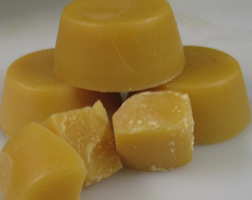Cutting Board Care and Cleaning Suggestions
Cutting board care and cleaning doesn’t have to be difficult! Here, we will detail a few simple steps to keep your wooden cutting board in great shape.
Before using a new butcher block, season it to prevent staining and absorption of food odors and bacteria. Proper surface treatment is important to guard against germs and/or mold growth on both new and older boards.
The wood surface needs an oil that can be repeatedly applied to fill the wood pores and repel food particles, liquids, and oils. Never use any vegetable or cooking oils to treat or finish a cutting surface, as in time the wood will reek of a rancid spoiled oil odor.

Chunks of beeswax for cleaning cutting boards.
USP-grade mineral oil is a popular choice for cutting board care and cleaning as it is the cheapest pure food-grade oil you can buy. Do not use vegetable or olive oils as they can turn rancid. Mineral oil remains safe throughout its life. There are various oils available for cutting boards and butcher blocks. Some are called “Butcher Block Finishes” or “Mystery Oil.” Save some money by visiting the local hardware or drug store and purchasing mineral oil (not mineral spirits – this is paint thinner).
For more information on oiling your kitchen cutting board and utensils, click here.
Beeswax is often added to mineral oil and walnut oil to give a tougher finish. The wax of bees has been used for centuries for waterproofing and sealing materials from baskets to cloth and for preserving foods and other perishable materials, including wood. It will make wood water-resistant (though not water-proof) and will help protect the wood surface from use and wear. It will also give a wood surface a nice smooth feel to the touch and leave a gentle, sweet fragrance. Simply shave about 1/2 teaspoon of beeswax into a microwave-safe dish with a cupful of mineral oil; microwave on high for about 45 seconds. Apply to the cutting board or butcher block while still warm. Save or dispose of the remainder of the oil.
A beeswax top coat is an optional addition to the re-finishing process but is well worth the time. The beeswax sits on the surface of the wood in contrast to the oil that soaks into the wood. As a result, the beeswax fills in pores and gaps that thin oil can’t bridge. This helps to keep moisture, bacteria, and other contaminants from getting into the wood surface. To apply the finish, simply wipe it on with a clean cloth. The beeswax is a soft paste that has a similar consistency to that of a shoe polish. The excess finish can be easily buffed off with the cloth. Once the finish has had some time to dry it can be buffed to a shine.
Before applying oil to the butcher block, warm the oil slightly. Apply oil with a soft cloth, in the direction of the grain, allowing the oil to soak in between each of the four or five coats required for the initial seasoning. After each treatment, wait about four to six hours and wipe off the oil that did not soak into the wood (oxidation or hardening of the oil will take approximately 6 hours). Re-oil the butcher block monthly or as often as needed.
About Us
At H. Arnold Wood Turning, we supply a wide variety of custom wood product solutions to fit your needs. For more on our wooden cutting board offerings, click here. If you need custom wood components, please feel free to reach out to us for a free, no-obligation estimate. We bring your ideas to life at competitive prices while making life easy.
